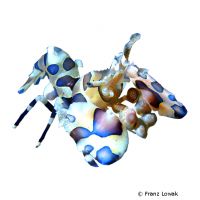Western Harlequin Shrimp (Hymenocera picta)
| Western Harlequin Shrimp Hymenocera picta | |
|---|---|
| Name | Western Harlequin Shrimp |
| Name Lat. | Hymenocera picta |
| Family | Harlequin Shrimps |
| Family lat. | Hymenoceridae |
| Order | Decapoda |
| Order lat. | Decapoda |
| Origin | Indian Ocean, Red Sea |
| Diet | Carnivore |
| pH | 8.1-8.4 |
| Hardness | 8-12 °KH |
| Lighting | Medium |
| Current | Weak |
| Behavior | Peaceful |
| Keeping | Pair |
| Care Level | Experts only |
| Life Span | 2-5 years |
| Protection | No |
| Metric Units | |
| Size | 5 cm |
| Temperature | 22-27 °C |
| Salinity | 33-36 ‰ |
| Aquarium | 100 l |
| US Units | |
| Size | 2" |
| Temperature | 72-81 °F |
| Salinity | 1.020-1.025 sg |
| Aquarium | 25 gal |
Distribution and habitat
The range of Hymenocera picta (Western Harlequin Shrimp) extends from the Red Sea to the Indo-Pacific, where they are found from the coast of East Africa to Indonesia and Australia. They live in pairs in the intertidal zone of coral reefs with populations of starfish, which are among their preferred food.
Maintenance
They require a well structured aquarium with a reef structure that allows for territoriality and at the same time provides shaded hiding and cover (caves, crevices)
Only lime-rich, heavy metal-free substrates may be used as substrate. To ensure water quality, filters, skimmers and heaters are necessary, as well as pumps to simulate tides, swells and bottom currents. It is recommended that live stones be used to set up the aquarium. The bacteria living in the porous stones act as a biological filter. The lighting must correspond to the species-appropriate day-night rhythm of the animals
| Salinity: 33-36 ‰ | pH value: 8.1-8.4 |
| Carbonate hardness: 6-10 °KH | Nitrate content: 2-8 mg/l |
| phosphate content: 0.01-0.1 mg/l | nitrite content: 0.0-0.05 mg/l |
Regular addition of trace elements, especially calcium, iodine and magnesium is recommended. For salinity, an average value should be aimed for, which may only vary slightly by +/- 0.5 ‰. Ammonia and ammonium must not be measurable. Special attention shall be paid to consistently good water quality and water values.
Diet
They are food specialists, feeding mainly on starfish. Nardoa, Linckia and Acanthaster species are preferred, adults also eat Asterias rubens, a starfish found in the North Sea. Frozen pieces of starfish are also accepted as substitute food. Especially when food is scarce, adults may behave predatorily against sea urchins.
Feeding should be done at least once a week, better more often. The food remains or dead starfish must be removed from the aquarium.
Behaviour and compatibility
In nature, they live in pairs and usually go hunting together. Accordingly, one pair should always be kept. They can be kept well in a coral reef tank with fish that they do not consider food. Keeping them together with echinoderms such as sea urchins or starfish is not possible, except as food animals.
Reproduction and breeding
Males are smaller than females and the tips of their abdominal legs are translucent
The male fertilizes the female immediately after molting. The female carries the eggs on her pleopods (swimming legs) for about 18 days. The larvae, which are only about 1.4 mm in size, feed on plankton (rotifers, copepods, Artemia nauplii). After another 5-7 weeks, the approx. 3 mm large juvenile shrimps settle on solid structures
Breeding in the aquarium has been successful several times
Important
They can be used well to control unwanted goosefoot starfish (Asterina spp.) in reef aquariums. Their large leaf-like claws are not used for hunting
If the water values are not appropriate, especially the nitrate value and iodine content should be paid attention to, moulting problems may occur.
If different species are kept together, ensure that fish and invertebrates are compatible in terms of water quality and temperature requirements and social behavior, and that the setup meets the ecological needs of all species kept together. Newly introduced animals must be acclimated slowly to the water in the aquarium
Further literature can be found in your pet store.
References
Text: Werner Winter; Image: Franz Lowak
Source: FOSSÁ & NILSEN (1995): Korallenriff-Aquarium Bd. 6, Birgit Schmettkamp Verlag; ENGELMANN & LANGE (2011): Zootierhaltung - Tiere in menschlicher Obhut: Wirbellose, Verlag Harri Deutsch
